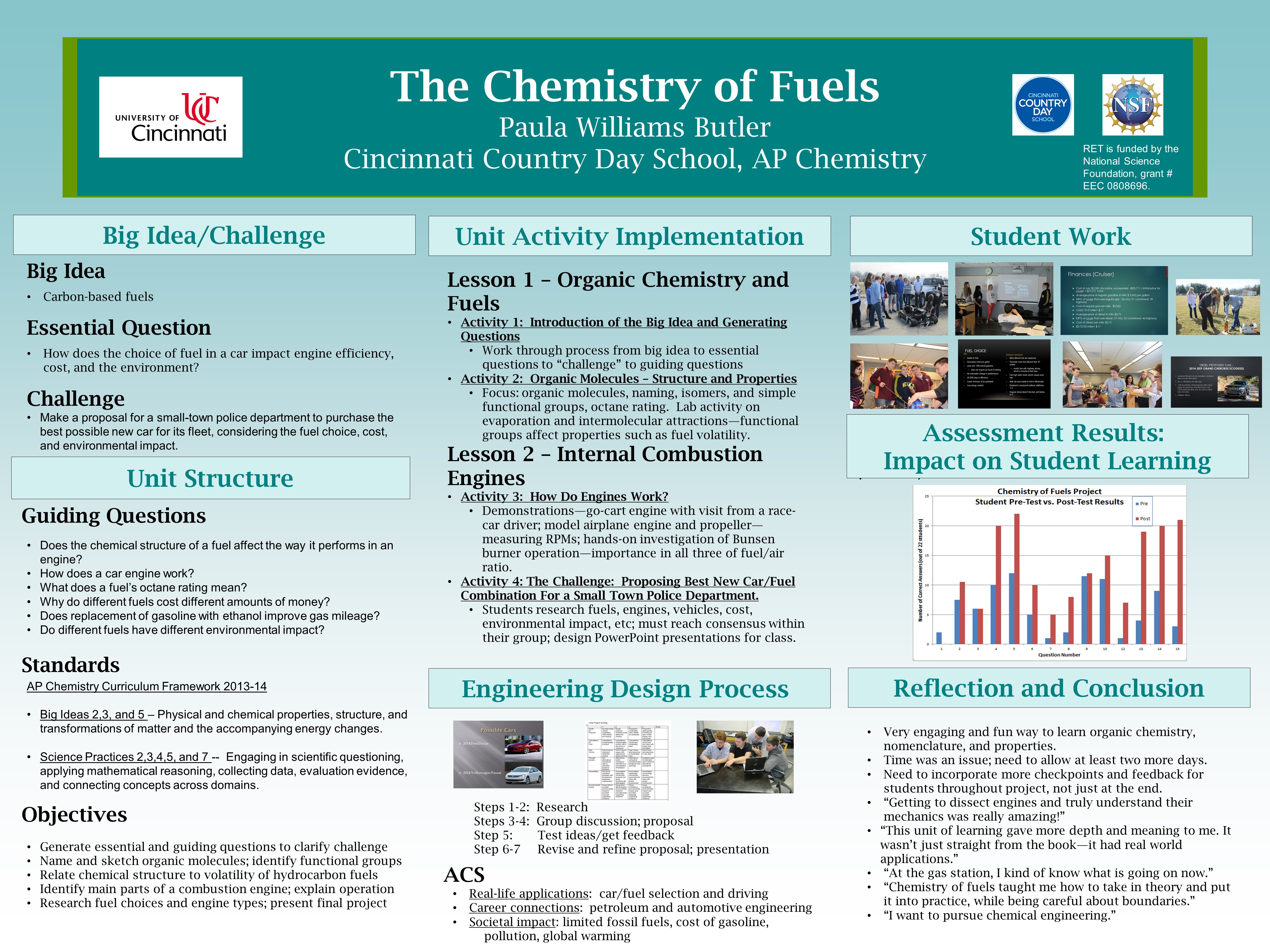Research Experience for Teachers (2013-2014)
Making Informed Choices for Today’s Cars
 |
||||||
|
||||||
|
Pre/Post Test: Pre Assessment |
||||||
|
The Big Idea (including global relevance) Carbon-Based Fuels |
|
Essential Questions How does the choice of fuel in a car impact engine efficiency, cost, and the environment? |
|
The Hook A series of slides will be shown including photos of gas pumps with the octane ratings, advertisements for new “flex-fuel” vehicles, a headline about new ethanol fuel guidelines, etc. |
|
The Challenge Design a detailed relief plan based on an infamous world disaster. This challenge will be the final activity after students will have already completed several small scale local challenges to build up to the culminating challenge. This plan will need to include accurate calculations for navigational directions, acceptable supply weight, fuel consumption, and flight times. Groups will present their final plans for students to vote on the best one. |
|
Guiding Questions
|
ACS (Real world applications; career connections; societal impact)
We are surrounded by real-world applications when we look at all of the vehicles on the roads and the search for better fuels. Many students are drivers, and they make decisions about what gasoline (or other fuel) to buy at the gas station. The real-world application piece will be most evident to the students in Activities 3 and 4, when they are exploring how engines work and then deciding the optimum combination of car and fuel choices in their challenge.
Some societal impact connections are the fact that fossil fuels are a limited resource, dependence on fossil fuels can lead to international conflict, and the burning of fossil fuels results in pollution and contributes to global warming. Societal impact will be introduced in Activity 1 when the students brainstorm the essential questions and the societal impact surrounding the big idea. Then, in Activity 4, for their challenge, they will expressly need to consider and defend their choice based in part on its environmental impact. Students will also be doing some readings about how the fuel choice in one country can sometimes have an unexpected consequence on the society in another country (by creating food shortages).
A STEM career related to this topic is chemical engineering for an oil company. The COFSP Fellow working with me will be discussing his recent internship with a Texas-based oil company with the students when we get to Activity 3.
Misconceptions
- Students often get confused about how to recognize and name organic isomers.
- Students often get confused about the difference between intermolecular forces and covalent bonds within a molecule.
- Students (and many adults) don’t understand the difference between the cycles in an engine (2-stroke vs. 4-stroke) and the number of cylinders in an engine (4 cylinder, V-6, V-8, etc.).
Unit Lessons and Activities
- Lesson 1: Introduction to Organic Chemistry and Fuels Lesson 1 will focus on giving students a working knowledge of organic molecules, nomenclature, isomers, and simple functional groups – particularly those that relate to fuel chemistry. Students will learn how octane rating is calculated. They will also do a lab activity on evaporation and intermolecular attractions—to see how functional groups affect properties such as volatility of a fuel in an engine.
- Activity 1: Introduction of the Big Idea, Generating the Essential Question, Challenge and Guiding Questions
- Activity 2: Organic Molecules – Structure and Properties
- Lesson 2: Internal Combustion Engines Lesson 2 will allow students to get some hands-on experience with a common laboratory reaction—the burning of gas in their Bunsen burner—to explore how changing the fuel/air ratio affects combustion. Students will then explore a two-stroke model airplane engine set up in the classroom and then tested outside to see how the fuel/air ratio affects the RPMs of the motor, the consumption of fuel, and the temperature of the engine. Students will get to see the inside of a real engine from a race-car driver who will visit our classroom, take apart an engine, demonstrate an operating go-cart engine, and answer questions. Finally, the challenge for students will be to make a proposal for a small-town police department to purchase the best possible new car for its fleet, considering the fuel choice, cost, and environmental impact.
- Activity 3: How Do Engines Work?
- Activity 4: The Challenge: Proposing the Best New Car/Fuel Combination For a Small Town Police Department
- Evidence of CBL: Lesson 1, Activity 1; Lesson 2, Activity 4
- Evidence of EDP: Lesson 2, Activity 4
Additional Resources
- A variety of readings and internet resources will be used.
- Excellent website for students to find information about internal combustion engines, diesel engines, gasoline, E85 fuel, octane rating, etc.
https://www.howstuffworks.com/ - Shere, Jeremy. Renewable: The World-Changing Power of Alternative Energy. St. Martin’s Press, 2013.
This book has five chapters under the heading of “Green Gas,” focusing on the history and predicted future of ethanol as a fuel. - Zolli, Andrew, and Ann Marie Healy. Resilience: Why Things Bounce Back. Free Press (Simon & Schuster, Inc.), 2012.
The introduction to this book makes a fascinating connection between food shortages in Mexico (due to rising corn prices) and the spike in ethanol investments which followed Hurricane Katrina in the U.S. There is also some discussion of other biofuels.
